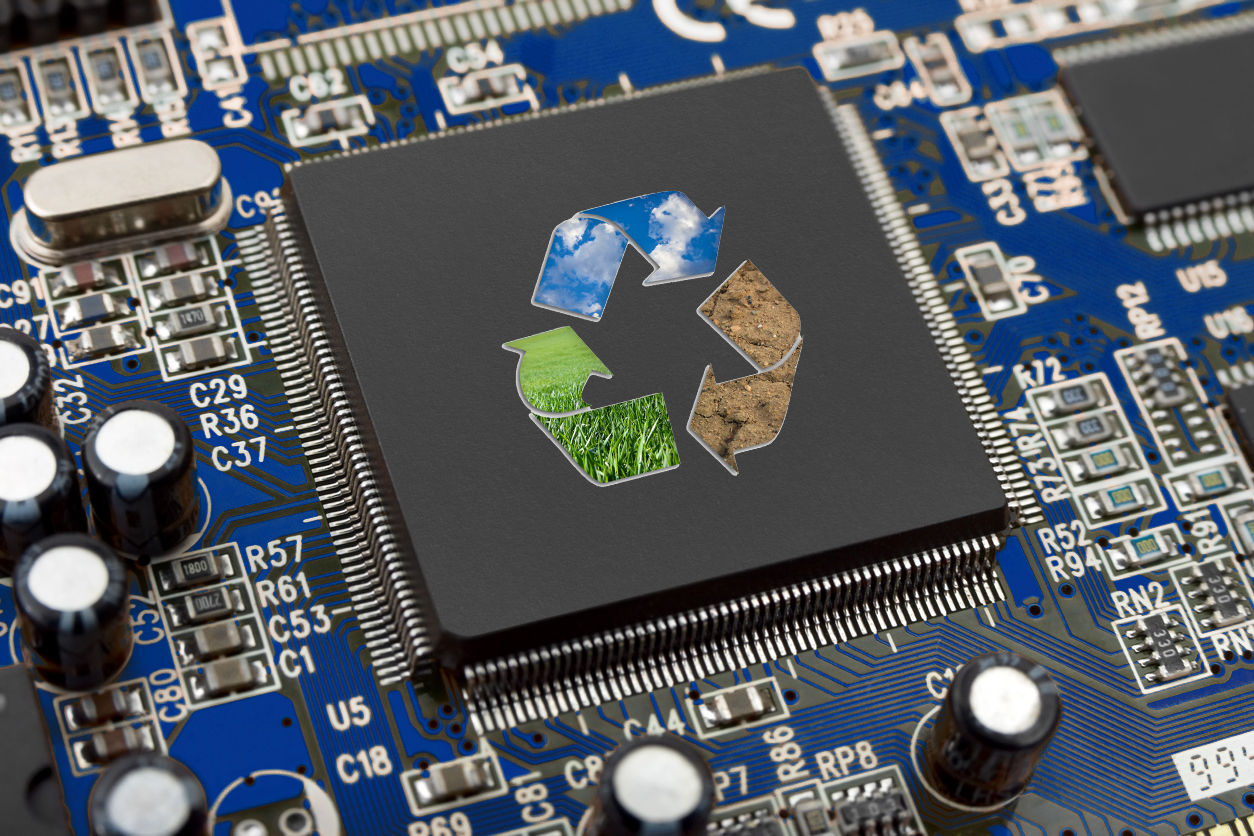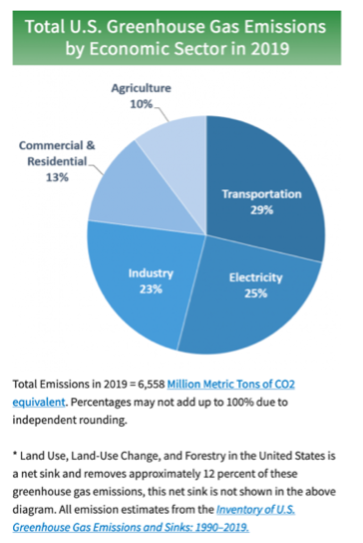
Global Warming is a hot topic lately, pun intended, contributing to an over 2-degree temperature increase in the last two centuries—which might not seem significant until you factor in the larger stress it puts on our ecosystem (and economy!): fire threats, water shortages, and increases in natural disasters. In the last four decades, damages from climate disasters have cost the US 2 trillion dollars (about $6,200 per person in the US). From a business economics standpoint, this is detrimental. From a humanitarian standpoint, this is unacceptable. It is our responsibility, as corporations, as inhabitants of this earth, to be responsible for our actions and hold each other accountable for making more sustainable choices.
The EPA created a breakdown of Greenhouse Gas Emissions per Economic Sector, with transportation, electricity, and industry being the three most prominent contributors—all sectors that are directly engaged in the semiconductor industry.
Being a global leader in the semiconductor industry, Brewer Science made it a mission to address the company’s environmental impact. Now achieving Zero Waste GreenCircle Certification for six consecutive years, along with several other honorable accolades such as becoming B Corp Certified™, the company shares its successful programs to encourage other industry partners to adapt their business models for more sustainable initiatives.
It is more than just global impact—it is about people.
Adapting sustainable practices has an impact far greater than global footprint—it impacts your people. Whether it is employees, customers, or investors, a successful business model relies on adapting to the demands of the stakeholders. As the global economy shifts to be more environmentally conscious, it is essential to address it with your business programs.
Environmental initiatives not only show stakeholders you are listening, but also allow you to attract high-caliber candidates from a wider application pool since studies show that one of the deciding factors for workplace selection among millennials is global impact and sustainability. This is quite evident at Brewer Science, where employee engagement has increased significantly, in part due to the environmental initiatives. Vicki Hallsworth, Director of International Human Resources at Brewer Science, states that there’s a common theme among recent applicants, “Employees seek to work at a place that they can call more than just a job but to know that they are making a positive impact in the world. They know that when they come into work each day they are contributing to a greater good and that the company’s mission aligns with their values, whether it be environmental responsibility or social impact.”
Small Initiatives lead to big impacts.
For an international corporation initiating new sustainability programs, it can be overwhelming and daunting trying to chart the unknown waters of conservation, reuse, and recycling. The key is to start small. Identify small initiatives that help your company gain momentum with the community and get employees engaged in thinking about sustainability. For example, Brewer Science hosts an annual Appliance, Tire, and Electronics recycling collection event in collaboration with local organizations, including the City of Rolla, Meramec Regional Planning Commission (MRPC), the Missouri Department of Natural Resources (MDNR), and Ozark Rivers Solid Waste Management District (ORSWMD). This simple endeavor diverted over 563 tons of residential material from landfills since we started the annual event in 2005 —not to mention it engaged other local organizations in partnership towards building a sustainable community.
For semiconductor companies, it is essential to evaluate the materials you are using in manufacturing and identify if there are more environmentally friendly alternatives, and responsibly handle the waste. Brewer Science established the Green Chemistry Program in 2019, which is an effort to identify chemical alternatives that are proven to be more sustainable, as well as divert hazardous materials for reuse applications. The reuse program handles waste materials for cleanup. When possible, the materials are used by partners who can use such materials or find alternative uses for them.
Any company can take a closer look at its energy use and applications. Are there energy alternatives you can utilize?
In 2017, our Rolla location started purchasing wind energy through renewable energy credits (REC), which are dependent on the allocations Rolla Municipal Utilities (RMU) determines. In 2017, RMU provided us with 6030 MWh of RECs. Between 2018 through 2021, the maximum RECs we received was 8000 MWh. In 2022, more RECs were available to be purchased, which enabled us to cover 100% of our Rolla electricity and a large portion of our Vichy electricity. Rolla and Vichy facilities have a 96% energy consumption coming from wind in 2022.
Take Measures to stay accountable.
Applying for programs and certifications helps you stay accountable, provides a framework for improvement, and allows you to be transparent with customers and the community. Annual certifications, such as ISO 14001 provide an audit that allows you to evaluate your processes for continuous improvement. B Corp Certification is renewed every three years and evaluates your company in more areas in addition to sustainability, including social responsibility activities such as diversity, inclusion, economic impact, supply chain management, and more. This framework allows you to benchmark your company’s initiatives to others in the industry to continually push each other to do better. Matt Beard, Director of Integrated Management at Brewer Science, emphasizes that sustainable practices are an ongoing concern that require continuous commitment; it’s not simply a check-the-box afterthought.
“Brewer Science remains committed to protecting the environment, conserving resources, and providing a healthy, safe, and secure workplace. Environmental responsibility is an ongoing priority at Brewer Science, as we continue to reduce our carbon footprint and partner with our customers, suppliers, employees, and the community to find new ways to have a positive impact on the environment,” said Matt. Brewer Science is targeting to reduce our Scope 1 and 2 greenhouse emissions by 80% by 2030.
Learn more about which certification processes are right for your company and will help you achieve your mission for sustainability. To help other companies get a start, Brewer Science produced this brief two-minute video on how to become GreenCircle Certified. In addition to applying for external certification, internally you can produce an annual corporate sustainability report. It is a fantastic way to highlight your achievements for employee engagement, customer recognition–and to keep yourself accountable to push for improvement in the next year.
Sustainability is becoming more of an urgent issue in the semiconductor industry, as more semiconductor companies understand that the demands of their consumers rely on eco-friendly practices. With the US rejoining the UN Climate Accord, and the new administration pushing America’s companies to reduce their carbon footprint and greenhouse gases, semiconductor companies need to be evaluating all means of their environmental impact. Reducing waste, evaluating materials used in manufacturing, and finding geothermal energy alternatives are just some of the methods industry leaders are making strides into becoming more environmentally conscious. Learn more about the sustainability initiatives Brewer Science is leading by visiting the Going Green page.
